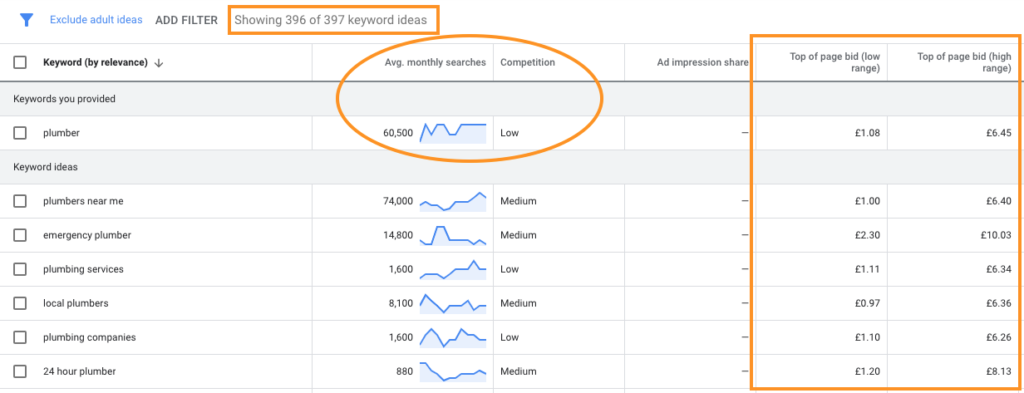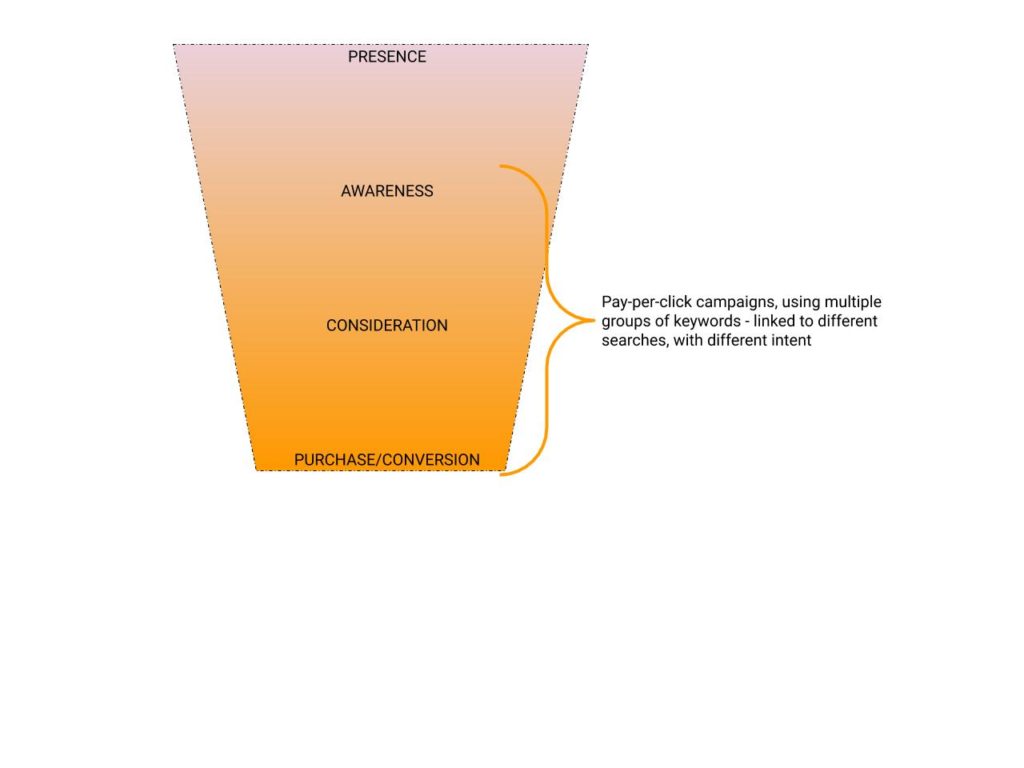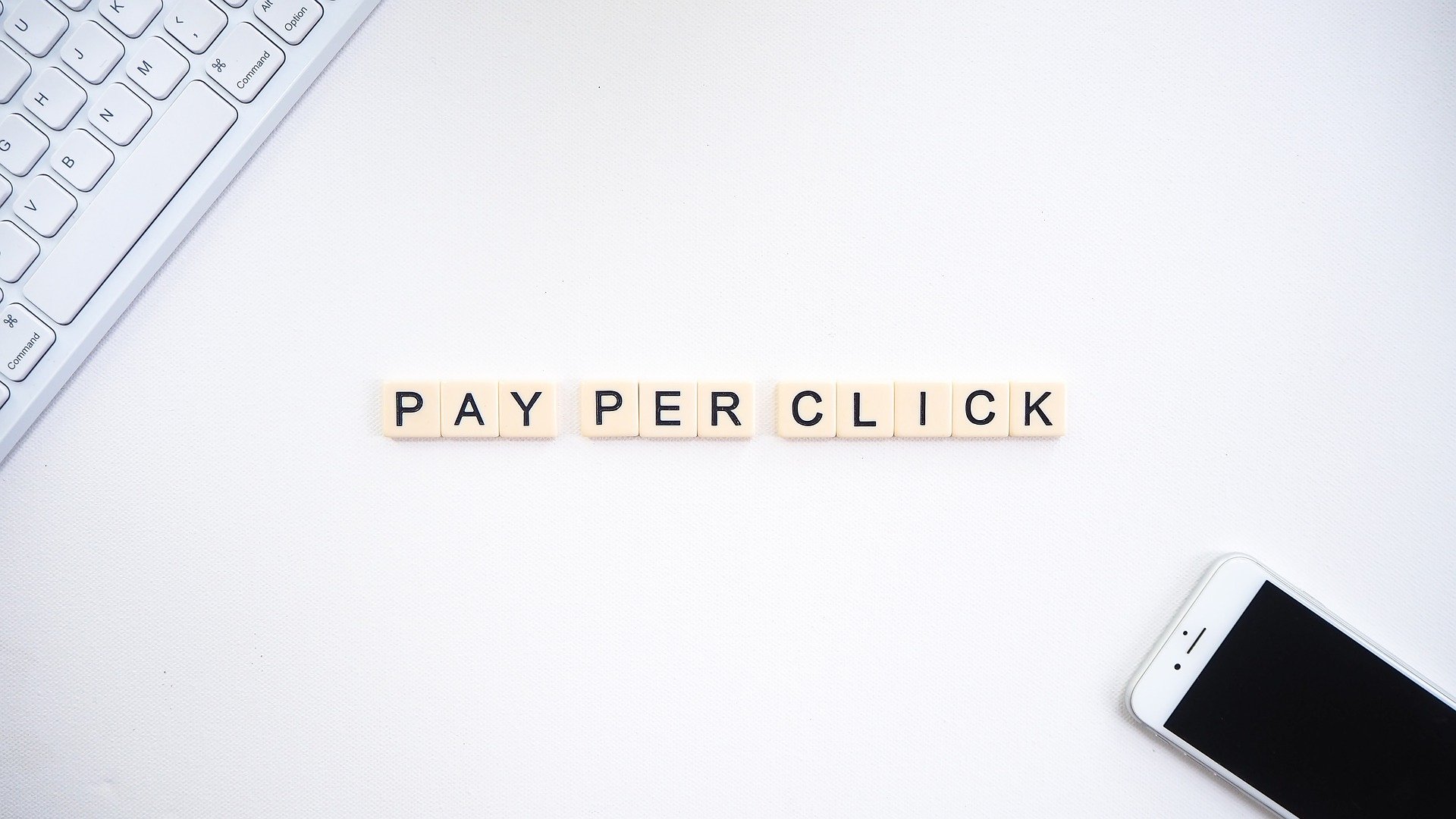In this article we are going to cover off some frequently asked basic questions around Google Ads, and also how PPC, or, Pay-per-click advertising can work for a business. It’s important to recognise how Google Ads can fit into an overall strategy along with the wealth of information it can provide you – which then feeds into other elements of marketing such as SEO or content production. We also cover our PPC process in more detail on this page.
Our next article, the advanced FAQ’s will cover the technical, more advanced parts of Google Ads – but if you are looking for a brief overview – you’ve come to the right blog!
Let’s start by covering off what PPC is, and what Google Ads are.
The main form of PPC advertising appears on search engine results pages after you have performed a search. You are then charged every time someone clicks on your advert, hence the name pay-per-click. Your adverts appear ‘for free’, based on keywords you target (more on that later), and hopefully the advert copy resonates enough with the web user to encourage a click.
When they click on the advert they go to a predefined landing page on your website. Where they land on your website can be customised to make sure it is a relevant page for the search term they have typed in.
PPC adverts, on Google or Bing are the text adverts that appear at the very top of search results, and sometimes you have a couple at the bottom of the page too.

On Google they have black text which says ‘Ad’ next to them, there can be up to 4 ads that appear at the top of the results page after you have searched Google before you see the organic (or ‘normal’) results. There are normally a few ads at the top, maybe some map listings, then the organic search results (10) and sometimes a few more ads at the bottom – but Google loves to change this layout so it can vary quite a lot!
Getting your website to rank in the ‘normal’ results comes down to your website’s SEO ranking, Search Engine Optimisation, which can be a very time consuming task. Therefore, PPC allows businesses a way to appear at the front of search results without using SEO tactics.
In a simple, basic example, say you are a plumber but your website is not appearing on the first few pages of Google when someone searches for ‘emergency plumber’ in your local area. You could run a PPC campaign, bidding on the term ‘emergency plumber’.
Someone goes to Google and types in ‘emergency plumber’ as they have a water leak, your PPC advert appears at the top (it looks just like a normal search result apart from the small ‘Ad’ text), the searcher clicks your ad and gets passed through to your website. You are then charged for that click.
This same principle applies to the Bing Ads but they appear on the Bing search engine, and there is an option for your ads to appear on ‘Google Search Partners’ which are alternative partner websites that Google Ads feed onto.
How much does Google Ads cost?
This varies massively depending upon the area you are targeting, and the keywords you would like to bid on. Google looks at the volume of people that are searching for that word and the amount of other advertisers that are already bidding on it. The more searches and the more people already competing to appear, the higher you would have to pay per click. Solicitors in London would cost a lot more than Plumbing in Pembrokeshire!
When you use an agency or consultant, they can run in depth research and compile a forecast for you based on different spend levels. For example, if you invest xx into Google you will get this many clicks, but if you invest this much you will get more.
The cost per click works on an auction basis, the more you are willing to pay, the more competitors you will outbid. However very little companies have an overall budget high enough to appear 100% of the time for all searches relevant to their business. Therefore the ads generally work on rotation and ‘everyone’ will get some impressions (views) due to the large volume of terms and search available. Although you set a maximum cost per click, most of the time you will pay less. A good result to monitor while running PPC is the average cost per click and weight that against your sales/conversions/leads to deem if it is providing ROI.
How do you know which terms to bid on?
This also comes down to research. Google have a tool called Google Keyword Planner which allows you to type in a few example terms relevant to your business, select an area and it will produce a long list of all the related terms people have typed into Google in the last 12 months, the amount of searches for each of those terms, and the potential maximum cost per click you may get charged.

Google Ads Keyword Planner
Sometimes there can be hundreds of things that people have typed in – even though they are looking for the same product or service like ‘Plumber near me’, ‘Emergency plumber’, ‘boiler repairs’, ‘boiler servicing’ – these are all terms from people ultimately looking for a plumber.
As there are quite often hundreds of potential, relevant keywords you can bid on, you need to analyse the potential cost per click, weighted against the size of the search volume and the competition level for that term. For smaller businesses you can get adequate coverage by only bidding on some of the available terms which have low or medium competition and average search volume. This can provide return on investment and sufficient reach on search engines without having to outlay massive amounts of investment.
Without going into the technicalities, the keywords you bid on are then matched to real life searches. You add keywords to your campaign and then set a match type (phrase, broad, exact or negative). This refines how you would like that keyword to be matched, for example, using plumbing as a keyword, set as broad, would mean you would also appear for ‘plumbing and heating’, ‘plumbing companies’, ‘plumbing companies near me’…and so on. Any query with the word plumbing in, even amongst other words, could trigger your advert to appear.
Using exact match generally means you would only appear for that exact keyword. So a plumbing keyword as an exact match would only match someone searching for plumbing.
It can be difficult to know how to decide which keywords to include, which match type to use so before we cover anything else you can see how intricate setting up a campaign can be.
Why use Google Ads?
As touched on earlier in this article, running an SEO strategy, Search Engine Optimisation, can take quite a long time to work and get your website ranking in the organic results on search engines.
Also, SEO is not guaranteed to work, and even if you do get some results, ranking on page 1 for the hundreds of terms that are relevant to your business is an ongoing and sometimes expensive task to deploy. Especially for most businesses.
Pay per click gives you the ability to bid on hundreds of relevant terms, and gain 1st page position for these without running SEO strategies.
Obviously this does also come at a cost, and you need to ensure that you have a long term strategy in place to prevent your business becoming heavily reliant on PPC alone to get traffic and response/sales. As more businesses use PPC the cost could increase in your sector and you would have no choice but to increase your investment as you are so reliant on PPC to keep your online presence active.
Ideally, you should run other marketing activities and an SEO strategy in the background. Once you start ranking for certain terms via SEO you can pull back spend on those terms with PPC.
While running a PPC strategy, within the Google Ads portal you can see the search terms that have been matched to your keywords/ads. This gives valuable insight into what customers are actually searching for related to your business. This can feed into a content or SEO strategy. There is no point ranking on page 1 for something people do not type in!
You can also create multiple versions of your ads to appear on Google. These will be tested on rotation and over time you will be able to see which adverts are getting the most clicks. This tells you the type of wording that is resonating best with your audience and generating clicks. The best wording can then be used in other marketing copy, online or offline and gives insight into the tone of voice your customers respond to.
Where does pay per click advertising fit into a marketing strategy?
Google Ads is great at reaching the mid to bottom funnel potential customers, but it isn’t great at driving brand awareness or increasing your brand being searched for.
By setting up a Google Ads campaign with lots of ad groups (separate small groups of different ads matched to different terms/objectives) you can accurately reach customers at the ‘consideration’ or ‘ready to purchase’ stages of their purchasing journey.
You can also add re-marketing lists and link your Google Ads so that your text ads appear to visitors after they have been on your website.
Google Ads covers a wide spectrum of the purchasing journey / consumer funnel as you are able to get your advert in front of people at lots of different stages, by using lots of different keywords. For example, someone searching for ‘bathroom companies near me’ is probably looking around at the different businesses and still doing research, whereas someone searching for ‘Best price on the xxx tap’ is likely to be ready to buy there and then and are just looking for the best price before they buy.

By running other marketing activities, at the top funnel / awareness stage (such as traditional, social, PR and sponsorships, targeted banners / programmatic), your brand awareness increases. This would help your Google Ads conversion rate – as people would already be familiar with your business. Running Google Ads alone is still very effective, but it won’t generate brand familiarity in the long term.
Read about our PPC process in more detail here.
Summary
- This is a basic overview of PPC advertising on Google or Bing. Essentially you can research into the things people are searching for, and choose to bid on those.
- Those terms are then matched to real life searches (depending upon the match type), and one of your adverts appears. When they are clicked on you are charged.
- The insight you gain is valuable, but be careful not to become too reliant.
In our next article we will delve deeper into the setup of Google Ads and it’s hierarchy. It is a very technical platform to use with different types of adverts you can run, different extensions you can add to your ads, you can target based on audience types/demographics (not just keywords), re-market to people who have visited your website and use advanced bid adjustments to automatically increase your reach for certain terms or based on days/times. It can be an extremely precise way to gain response.
We will also cover how to accurately monitor response and goals/conversions which can be set up to show you the ROI being generated whether it is sales through your checkout, or contact forms…etc being filled in.
Contact us to discuss your marketing or PPC requirements in more detail and we can provide a free tailored suggestion.


